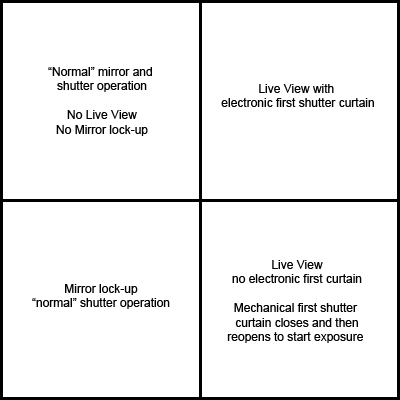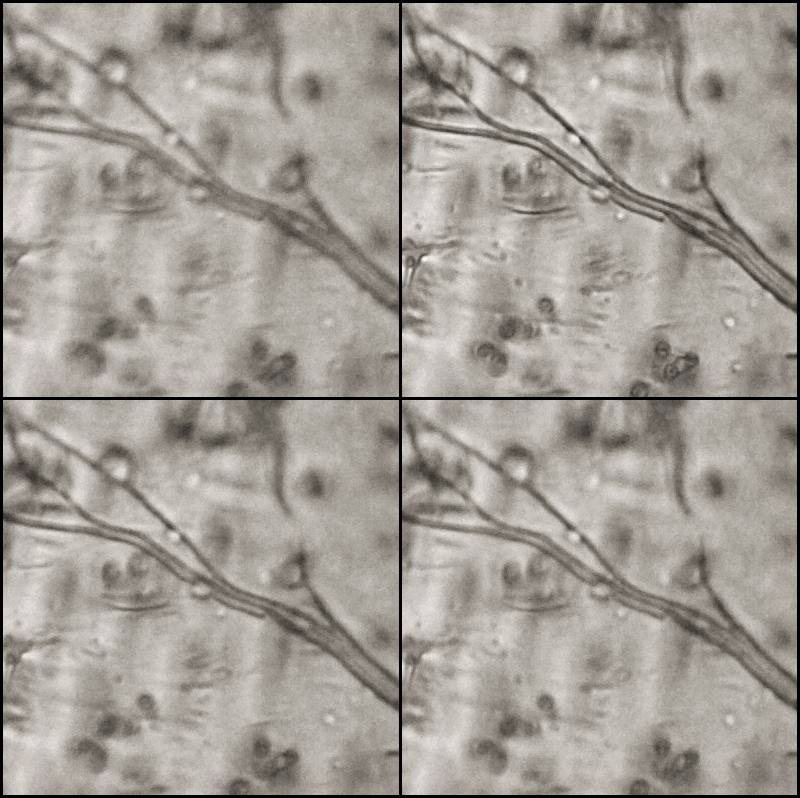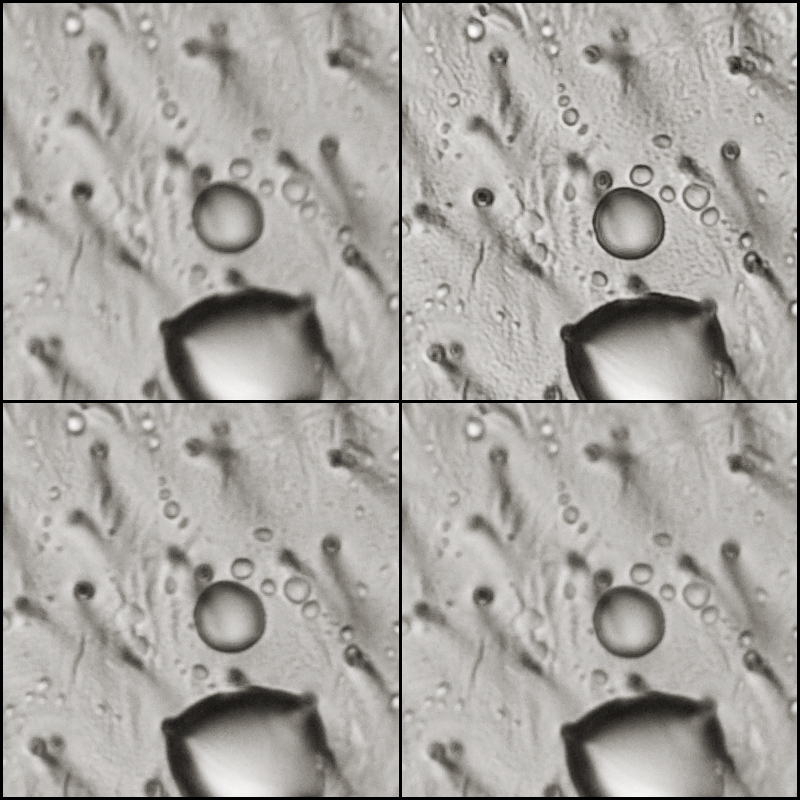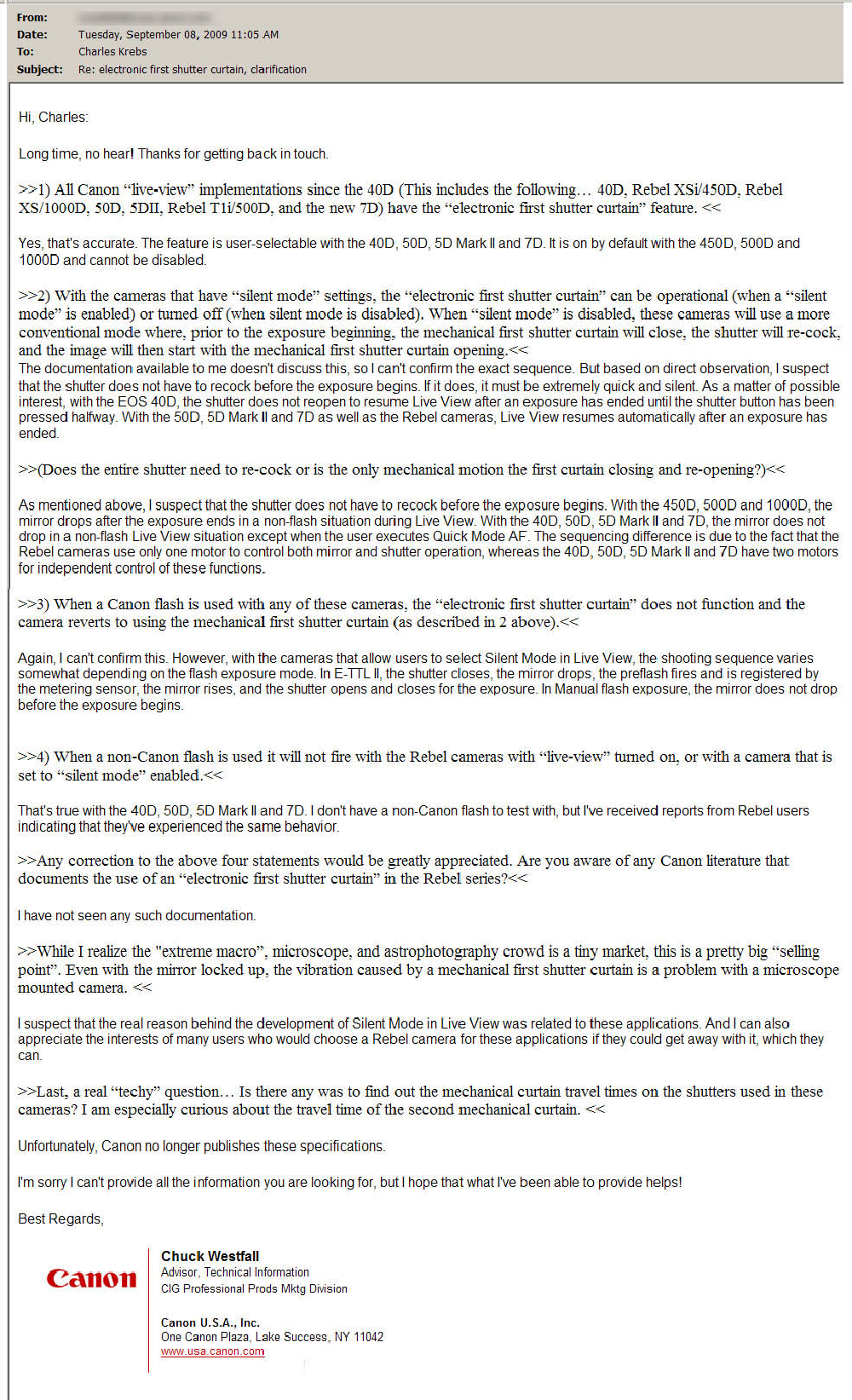
Canon “Live-
A solution for SLR vibration issues with microscope mounted camera?
Those of us using SLR cameras for photomicrography are very much aware of the vibration caused by both the camera mirror mechanism and the camera focal plane shutter. It’s common knowledge that the mirror is the bigger culprit, but at the high magnifications possible with a microscope the camera shutter is also a significant problem.
Many Canon DSLRs with the “live-view” feature have an interesting feature. They can eliminate the need for a mechanical first shutter curtain by using “a unique high-speed scanning and electronic reset system that accurately mimics the... high-speed mechanical shutter operation. It synchronizes with the mechanical 2nd-curtain shutter to obtain a slit exposure.” In addition, the way live-view has been incorporated in these camera bodies the exposure can be initiated while in “live-view” without any mirror motion. As a result, an exposure can begin with absolutely no mechanical movement at all, and thus no vibration. The exposure is concluded by the closing of the mechanical second shutter curtain. After the exposure there will be some mechanical movement in the camera but this obviously can not effect the exposure (with the possible exception of a continuous “burst” of successive pictures).
Canon documented this feature with the 40D, 50D, 5DII, and 7D. They promoted it as “silent-mode”. Although not documented by Canon, this same feature (electronic first shutter curtain) is also found in the Rebel XSi/450D, Rebel XS/1000D, and Rebel T1i/500D. With these camera’s it is always “on” and there is no “silent-mode” to enable or disable.
Curiously, in the Canon documents that did mention this feature there was no mention of the fact that this would not only make the camera “quieter” but could significantly lower shutter induced vibration.
These cameras seemed like excellent candidates for use with a microscope. This is the reason for this test.
Many Canon DSLRs with the “live-
Canon documented this feature with the 40D, 50D, 5DII, and 7D. They promoted it as “silent-
Curiously, in the Canon documents that did mention this feature there was no mention of the fact that this would not only make the camera “quieter” but could significantly lower shutter induced vibration.
These cameras seemed like excellent candidates for use with a microscope. This is the reason for this test.
The samples below were all taken with a Canon 50D body mounted on the trinocular tube of an Olympus BHA compound microscope. The objective used was an Olympus S Plan Apo 20/0.70. The trinocular tube was fitted with an Olympus NFK 2.5XLD photo eyepiece, which projected the image directly onto the camera sensor.
This resulted in a magnification of 50X on sensor. This camera sensor has 4752x3168 pixels. Each of the four squares making up a comparison image is a 400x400 pixel section cropped from the center of the frame, shown here at 100%. These 400x400 pixel squares represents a “real life”, subject field size of .0375 x .0375 mm or (.0015 x .0015 inches). All images were processed identically.
Lighting was oblique brightfield. The shutter speed for all images was 1/30 second.
The subject was the wing of a crane fly. No attempt was made to take an “attractive” image of the subject, but several pictures were composed that included some clear, fine detail for comparison purposes. I did quite a few comparisons and the results were the same in each case. Three representative comparisons are presented here. My observations are included below the images.
This resulted in a magnification of 50X on sensor. This camera sensor has 4752x3168 pixels. Each of the four squares making up a comparison image is a 400x400 pixel section cropped from the center of the frame, shown here at 100%. These 400x400 pixel squares represents a “real life”, subject field size of .0375 x .0375 mm or (.0015 x .0015 inches). All images were processed identically.
Lighting was oblique brightfield. The shutter speed for all images was 1/30 second.
The subject was the wing of a crane fly. No attempt was made to take an “attractive” image of the subject, but several pictures were composed that included some clear, fine detail for comparison purposes. I did quite a few comparisons and the results were the same in each case. Three representative comparisons are presented here. My observations are included below the images.
The scale bar applies to all three comparisons.
The sections are placed as shown in the first diagram.
Clearly the upper left frame is the worst in each group. The combination of mirror action and mechanical focal plane shutter operation causes enough vibration to seriously degrade the image quality. (This is the reason I have, in the past, mounted my camera on a separate stand with no “hard” contact with the microscope).
The upper right is clearly the best in each group. This was the image taken with “Live View” active, and the “silent mode” turned on. So for this image the Canon 50D camera used an “electronic first shutter curtain”.
The lower left image in each set was taken using the mirror-lockup feature of the camera. The mirror was first “locked up”, and after a pause of a couple seconds the shutter was released. These were the second best image in each comparison, but significantly lower quality than with the “electronic first shutter curtain”. It is interesting to compare this image with the one in the upper right corner. This gives some indication of the degree to which a mechanical first shutter curtain can cause vibration problems.
The lower right image was taken with “Live View” active, but the “silent mode” was disabled. This means that before the exposure starts the mechanical first shutter curtain first closes, and then reopens to start the exposure. (Note that with the Rebel XSi/450D, Rebel XS/1000D, and Rebel T1i/500D there is no way to “disable” the electronic first shutter curtain). These results are interesting. The result is clearly better than the upper left image. But it is slightly worse than the one taken using the only the mirror lock-up. This is really not that surprising, since there are two mechanical actions occurring that can cause vibration ... the mechanical first shutter curtain must close and and then re-open. With mirror lock-up there is only one mechanical action that can cause vibration... the first shutter curtain opens to begin the exposure.
These were all taken at 1/30 second. So far I have tested shutter speeds in the range of ½ to 1/250 second. In each case the images made using the electronic first shutter curtain were superior. At this time I am only looking at usage with continuous illumination. Electronic flash is sometimes used to “freeze” the motion of live subjects, and it is also an excellent method of avoiding vibration difficulties. But it can be cumbersome to set up, and many microscopists do not need it for their subjects. For continuous light, one of these bodies could avoid the need to mount the camera on a separate stand or incorporate electronic flash.
I imagine results will vary with different microscopes... clamp on of these cameras onto an old 75 pound Zeiss Photomicroscope and then a less hefty model weighing 1/5th as much and you would naturally expect some difference. The vibration problems would also be less noticeable at lower magnifications, and more of a problem at higher magnification. But at the time I write this (September 2009) these are the only DSLR cameras I would mount directly on a microscope.
Charles Krebs
The upper right is clearly the best in each group. This was the image taken with “Live View” active, and the “silent mode” turned on. So for this image the Canon 50D camera used an “electronic first shutter curtain”.
The lower left image in each set was taken using the mirror-
The lower right image was taken with “Live View” active, but the “silent mode” was disabled. This means that before the exposure starts the mechanical first shutter curtain first closes, and then reopens to start the exposure. (Note that with the Rebel XSi/450D, Rebel XS/1000D, and Rebel T1i/500D there is no way to “disable” the electronic first shutter curtain). These results are interesting. The result is clearly better than the upper left image. But it is slightly worse than the one taken using the only the mirror lock-
These were all taken at 1/30 second. So far I have tested shutter speeds in the range of ½ to 1/250 second. In each case the images made using the electronic first shutter curtain were superior. At this time I am only looking at usage with continuous illumination. Electronic flash is sometimes used to “freeze” the motion of live subjects, and it is also an excellent method of avoiding vibration difficulties. But it can be cumbersome to set up, and many microscopists do not need it for their subjects. For continuous light, one of these bodies could avoid the need to mount the camera on a separate stand or incorporate electronic flash.
I imagine results will vary with different microscopes... clamp on of these cameras onto an old 75 pound Zeiss Photomicroscope and then a less hefty model weighing 1/5th as much and you would naturally expect some difference. The vibration problems would also be less noticeable at lower magnifications, and more of a problem at higher magnification. But at the time I write this (September 2009) these are the only DSLR cameras I would mount directly on a microscope.
Charles Krebs




I would like to thank Chuck Westfall of Canon USA for answering some of the questions I had about this feature in Canon cameras. I had emailed him with my “understanding” of the situation and he replied with corrections and clarifications. With his permission I am including below a copy the email. For many years Mr Westfall has been a tremendous “resource” for great Canon information.
